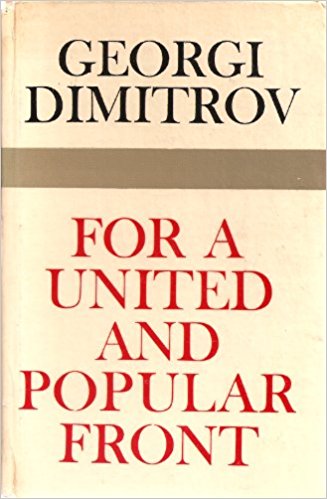The Popular Front: the Deadest of Dead-End Strategies

A few days ago, Paul Krehbiel—a member of the Committees of Correspondence, an organization with roots in a split from the Communist Party USA in 1991—had an essay posted on Portside entitled "United and Popular Front: Lessons from 1935-2017."
Krehbiel usefully describes both a United Front and a Popular Front:
The United Front and Popular Front strategy was developed by Georgi Dimitrov, leader of the Bulgarian Communist Party and a leader of the Communist International. Dimitrov presented his strategy at the Seventh Congress of the Communist International in 1935. He said that all working-class and socialist organizations should work together in a United Front to defend their interests, and to resist and fight to defeat and overthrow fascism. He then said this United Front should also promote the creation of a broader, Popular Front, that would be comprised of the forces in the United Front but would reach out to all other sectors of society that are against fascism, including capitalists who opposed it.
Krehbiel argues that in the face of the fascist potential of the Trump administration, it is time once again to revive Dimitrov's strategy, which Krehbiel sees as a success, both in the U.S. and elsewhere.
My response, also posted on Portside, is as follows:
Paul Krehbiel neglects to mention that the Communist Party USA's devotion to a Popular Front strategy led to the Party becoming, essentially, cheerleaders for FDR and opponents of the creation of an independent labor party in the United States. This was a disastrous decision which we are all still paying for. Reaching back to the Popular Front today, when the dominant wing of the Democratic Party isn't even as quasi-social democratic as the New Deal Democrats were, is nonsensical. Hillary Clinton in particular is no New Deal Democrat supporting "many social programs" and "helping children"! Doug Henwood's book on Clinton makes this quite clear.Furthermore, no country "overthrew fascism and established socialism." At least for terribly orthodox Marxists such as myself, "socialism" means the classless society. The classless society has yet to be created—and Stalinism, a term absent from Paul's article, was in no way socialist or even working-class in character. (Moreover, "socialism" in Eastern Europe was achieved via Russian tanks, not through popular revolution.)Paul also doesn't mention that the CPUSA put its forthright opposition to Jim Crow "on hold" for the duration of the Second World War, which is why black socialists like Bayard Rustin and A. Philip Randolph either left the party or simply wanted nothing to do with it.If one wants to argue that under current conditions there's often no choice in the U.S. but to merely vote for Democrats against Republicans (Cadets versus the Black Hundreds, as Lenin might have put it) then one can do that without invoking Dimitrov's discredited pamphlet, which in practice led to the end of criticism of the "left" bourgeois and social-democratic parties that the Communist Parties aligned themselves with, in government, which helped lead to the disasters of the Popular Front in Spain, Chile, Indonesia…not to mention the "Salerno Turn" which led Palmiro Togliatti's Italian Communist Party to give up the possibility of socialist revolution for a "government of national unity" after the overthrow of Italian fascism.Let's bury Dimitrov—and Stalin—for good.
The Popular Front was designed in the Soviet Union, not as means towards a revolutionary strategy for socialist transformation, but to block such a possibility. The Stalinist regime was in the midst of consolidating its power in the 1930s. It wanted nothing more than to be left in splendid isolation—to build "socialism in one country." Stalin feared both a defeat of fascism by workers' revolution and by war. Workers' revolution in the "West," particularly in Spain or Germany, might embolden the Russian working class to against the Stalinist party-state. And the Kremlin, acting on that fear, sabotaged those revolutionary challenges at every turn.
The Popular Front was designed to convince the Nazis that unless they sought a separate accord with Stalin, the USSR was prepared to align itself with the West. The Popular Front was, plainly, a counterrevolutionary strategy designed to assist the Stalinist regime in stabilizing its rule. It was self-consciously counterrevolutionary.
All the more reason to consign the Popular Front to the dustbin of history.